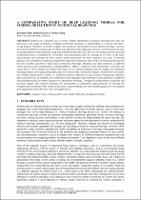Chapter A Comparative Study of Deep Learning Models for Symbol Detection in Technical Drawings
Author(s)
Gann, Damaris
Faltin, Benedikt
König, Markus
Language
EnglishAbstract
Symbols are a universal way to convey complex information in technical drawings since they can represent a wide range of elements, including components, materials, or relationships, in a concise and space-saving manner. Therefore, to enable a digital and automatic interpretation of pixel-based drawings, accurate detection of symbols is a crucial step. To enhance the efficiency of the digitization process, current research focuses on automating this symbol detection using deep learning models. However, the ever-increasing repertoire of model architectures poses a challenge for researchers and practitioners alike in retaining an overview of the latest advancements and selecting the most suitable model architecture for their respective use cases. To provide guidance, this contribution conducts a comparative study of prevalent and state-of-the-art model architectures for the task of symbol detection in pixel-based construction drawings. Therefore, this study evaluates six different object detection model architectures, including YOLOv5, YOLOv7, YOLOv8, Swin-Transformer, ConvNeXt, and Faster-RCNN. These models are trained and tested on two distinct datasets from the bridge and residential building domains, both representing substantial sub-sectors of the construction industry. Furthermore, the models are evaluated based on five criteria, i.e., detection accuracy, robustness to data scarcity, training time, inference time, and model size. In summary, our comparative study highlights the performance and capabilities of different deep learning models for symbol detection in construction drawings. Through the comprehensive evaluation and practical insights, this research facilitates the advancement of automated symbol detection by showing the strengths and weaknesses of the model architectures, thus providing users with valuable guidance in choosing the most appropriate model for their real-world applications
Keywords
Computer Vision; Technical Drawings; Symbol Detection; Comparative StudyDOI
10.36253/979-12-215-0289-3.87ISBN
9791221502893, 9791221502893Publisher
Firenze University PressPublisher website
https://www.fupress.com/Publication date and place
Florence, 2023Series
Proceedings e report, 137Classification
Virtualization


 Download
Download Web Shop
Web Shop